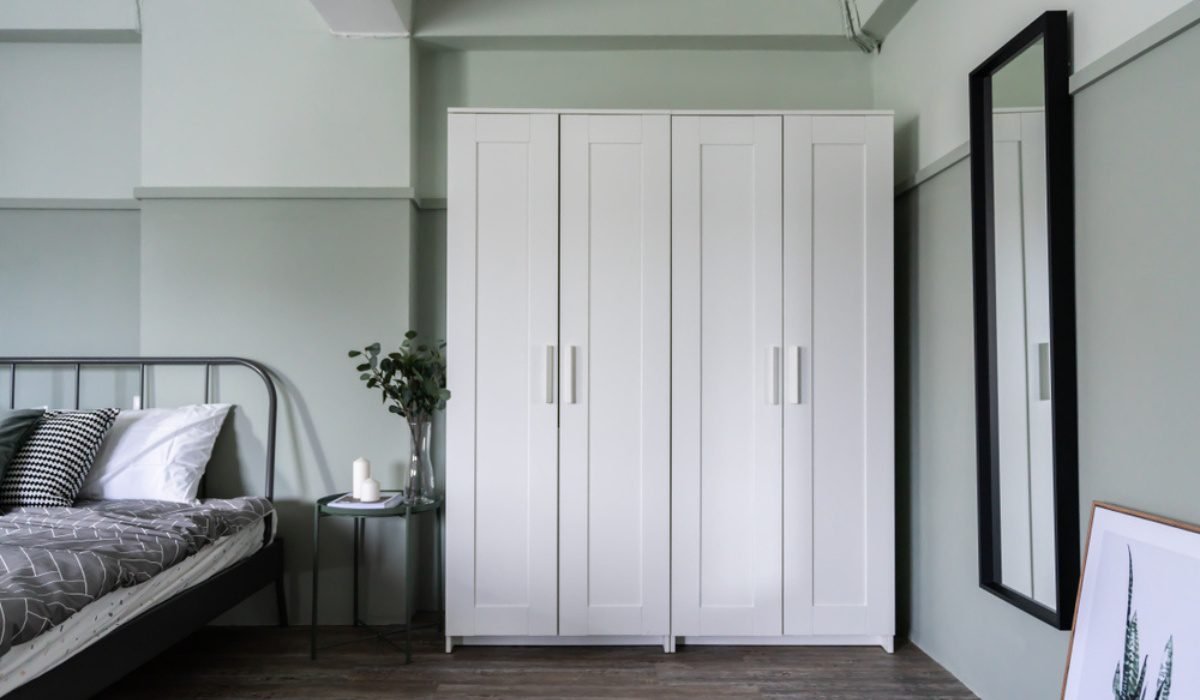When it comes to designing a bedroom, one of the key elements to consider is the cupboard or wardrobe. However, selecting the right material for your cupboard can often be a daunting task, especially if you’re working within a budget. In this article, we explore various budget-friendly options for bedroom cupboard materials that offer both durability and aesthetic appeal. From versatile laminates to cost-effective MDF, we’ll understand the pros and cons of each material, providing valuable insights to help you take an informed decision for your bedroom storage solution.
Budget bedroom cupboard materials
Discover the top pocket-friendly cupboard materials for your bedroom.
Bedroom cupboard materials #1: Particleboard
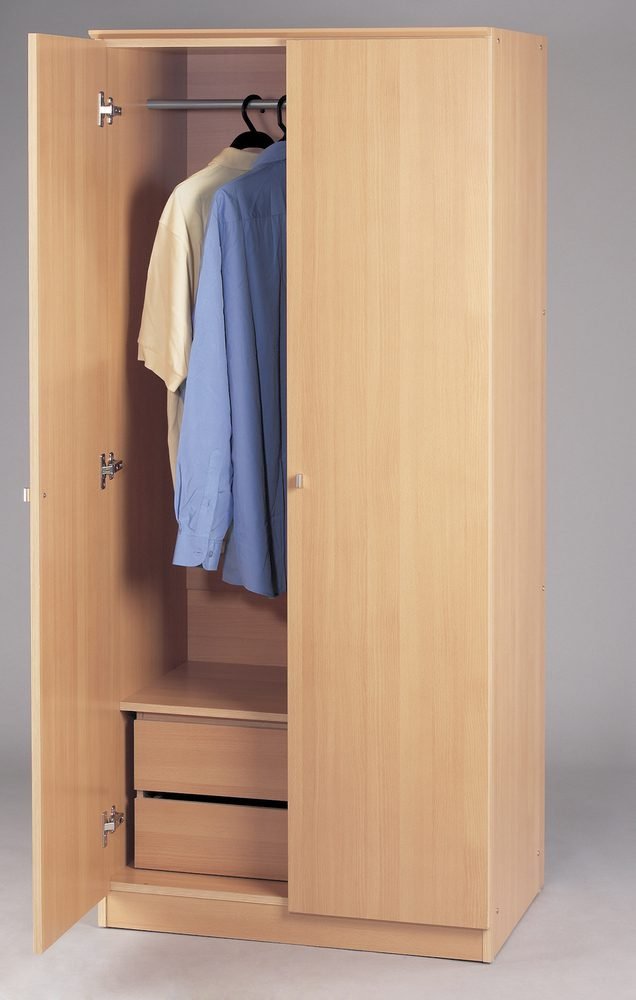
Particleboard, also known as chipboard, is a popular choice for bedroom cupboards due to its affordability and versatility. It is made from wood particles and resin bonded together under heat and pressure.
Pros:
- Cost-effective: Particleboard is one of the most budget-friendly options for cupboard materials, making it ideal for those looking to save money without compromising on quality.
- Smooth surface: It provides a smooth surface finish, which can be easily painted or laminated to match any bedroom decor.
- Uniformity: Particleboard offers uniform density and thickness, ensuring consistency in the cupboard’s construction.
- Eco-friendly: It is often made from recycled wood particles, making it a sustainable choice for environmentally conscious consumers.
Cons:
- Susceptible to moisture: Particleboard is prone to swelling and warping when exposed to moisture, so it may not be suitable for areas with high humidity levels.
- Less durable: Compared to solid wood or plywood, particleboard is less durable and may not withstand heavy loads or frequent use as well.
- Limited strength: It has lower strength and screw-holding capacity compared to other materials, which may affect the longevity of the cupboard.
- Formaldehyde emissions: Some particleboard products may emit formaldehyde, a volatile organic compound (VOC), which can contribute to indoor air pollution and pose health risks if not properly sealed or ventilated.
Bedroom cupboard materials #2: Medium Density Fiberboard (MDF)
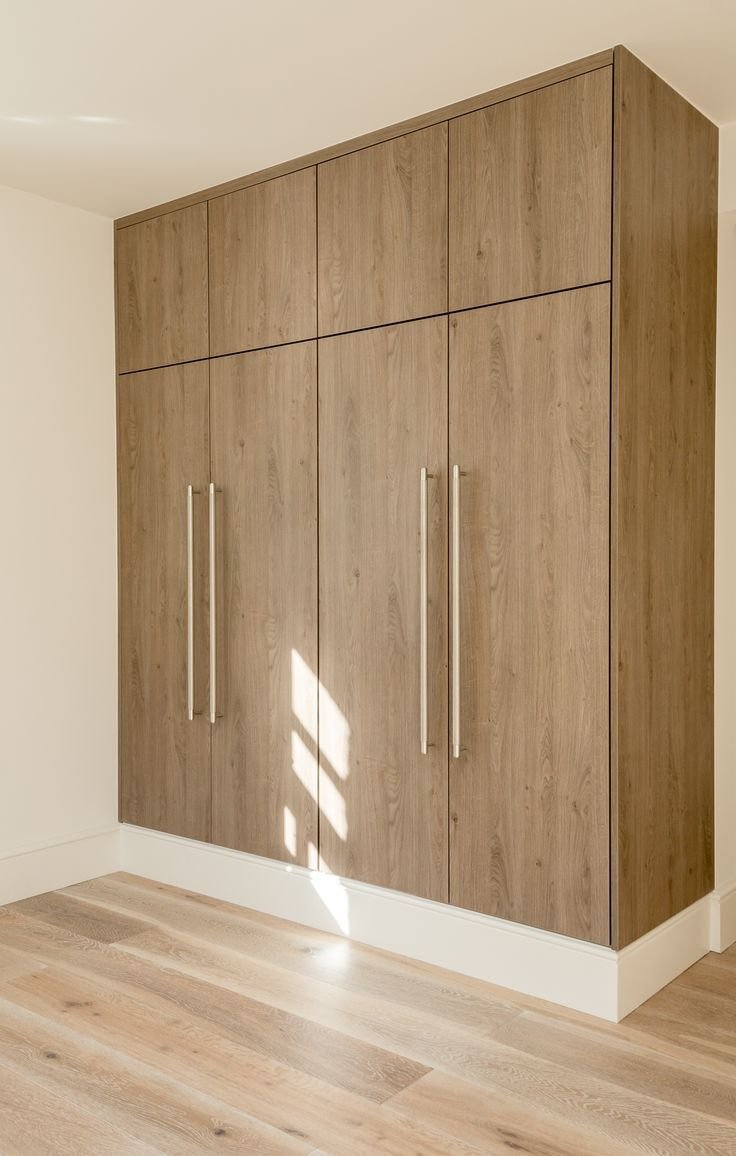
Source: Pinterest/oxan_furniture
Medium Density Fiberboard (MDF) is a popular choice for bedroom cupboards, offering a balance between affordability and quality. It is made from wood fibres and resin compressed under high pressure and temperature.
Pros:
- Smooth surface: MDF provides a smooth and uniform surface finish, making it ideal for painting, laminating, or veneering to achieve various aesthetic style.
- Cost-effective: It is more affordable than solid wood or plywood, making it a budget-friendly option for those seeking high-quality cupboards.
- Versatility: MDF can be easily machined, allowing for intricate designs and customisations to meet specific design preferences.
- Stability: Unlike solid wood, MDF is less prone to expansion and contraction due to changes in temperature and humidity, ensuring dimensional stability over time.
Cons:
- Moisture sensitivity: MDF is susceptible to moisture damage and may swell or warp if exposed to high level of humidity or water, so it may not be suitable for areas prone to moisture.
- Weight: While MDF is denser than particleboard, it is still heavier than solid wood, which may require additional support or reinforcement for large cupboard designs.
- Limited load-bearing capacity: MDF has lower load-bearing capacity compared to solid wood, so it may not be suitable for heavy-duty applications or shelves carrying substantial weight.
- Formaldehyde emissions: Some MDF products may contain formaldehyde-based adhesives, which can emit VOCs and pose health risks if not properly sealed or ventilated.
Bedroom cupboard materials #3: Plywood
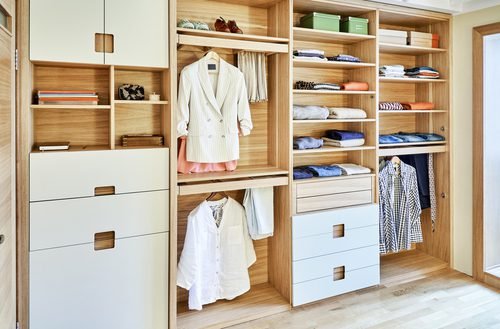
Plywood is a versatile and widely used material for bedroom cupboards, known for its strength, durability, and versatility. It is made from thin layers of wood veneer (called plies) that are glued together with the grains of adjacent layers perpendicular to each other.
Pros:
- Strength and durability: Plywood is known for its strength and durability, making it suitable for building sturdy and long-lasting cupboards that can withstand everyday wear and tear.
- Dimensional stability: Unlike solid wood, plywood is less prone to warping, shrinking, or expanding due to changes in temperature and humidity, ensuring stability over time.
- Wide range of options: Plywood comes in various grades, thicknesses, and finishes, offering flexibility to choose the right type for different cupboard designs and aesthetic preferences.
- Easy to work: Plywood can be easily cut, shaped, and drilled, allowing for intricate designs and customisations to meet specific requirements.
Cons:
- Cost: Plywood is generally more expensive than particleboard and MDF, which may affect its affordability for budget-conscious consumers.
- Weight: While plywood is lighter than solid wood, it is heavier than particleboard and MDF, requiring additional support for large cupboard designs.
- Veneer quality: The quality of the outer veneer layers can vary depending on the grade of plywood, with lower grades having more visible defects or patches.
- Moisture resistance: While some types of plywood are treated to be moisture-resistant, others may be susceptible to damage if exposed to high level of humidity or water, necessitating proper sealing, or finishing for protection.
Bedroom cupboard materials #4: Laminate

Laminate is a popular choice for cupboard surfaces due to its affordability, durability, and wide range of design options. It consists of a thin layer of decorative paper or fabric impregnated with resin and bonded to a substrate material like particleboard, MDF, or plywood.
Pros:
- Affordability: Laminate is one of the most budget-friendly cupboard materials available, offering a cost-effective option for achieving various aesthetic looks.
- Durability: Laminate surfaces are highly resistant to scratches, stains, and moisture, making them ideal for use in bedrooms where durability is needed for long-term use.
- Easy maintenance: Laminate surfaces are easy to clean and maintain, requiring only regular wiping with a damp cloth to keep them looking new and fresh.
- Versatility: Laminate comes in a wide range of colours, patterns, and textures, allowing for endless design possibilities to suit different interior styles and preferences.
Cons:
- Limited repairability: While laminate is durable, it can be challenging to repair if damaged. Scratches or chips may be difficult to fix, often requiring the replacement of the entire surface.
- Susceptibility to heat: Laminate surfaces can be damaged by high temperature, such as hot pans or dishes, causing discolouration or warping if not adequately protected.
- Edge durability: The edges of laminate surfaces may be vulnerable to chipping or peeling over time, especially in areas with heavy use or frequent impact.
- Environmental impact: Some laminates may contain chemicals or adhesives that emit VOCs, contributing to indoor air pollution and potential health concerns. Opting for low-VOC or eco-friendly laminate options can help mitigate these risks.
Bedroom cupboard materials #5: Melamine
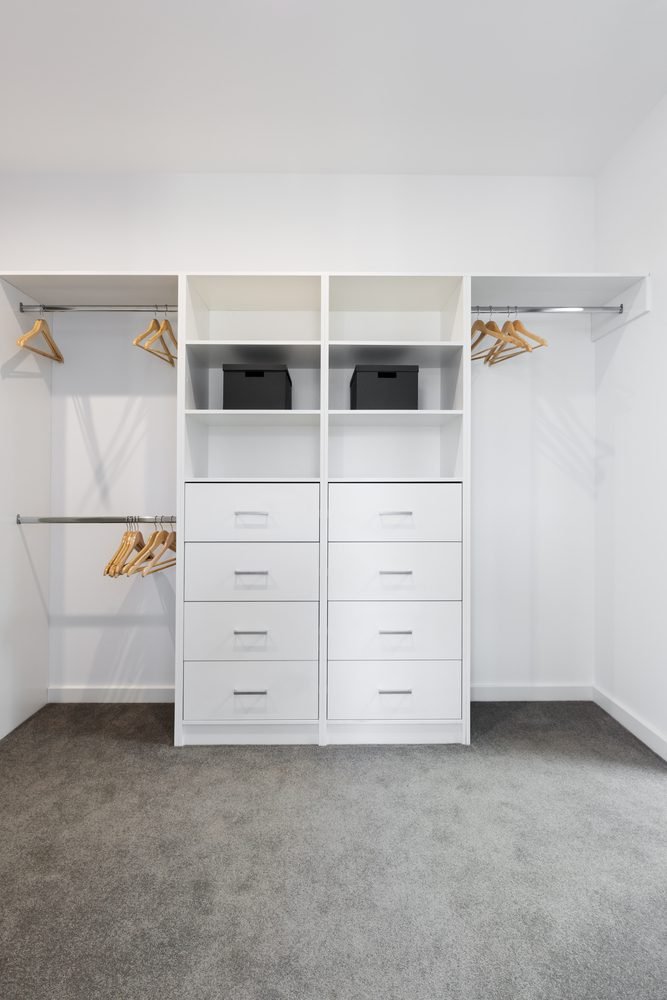
Melamine is a synthetic resin material commonly used as a surface finish for cupboard interiors and occasionally for exteriors. It’s created by combining melamine resin with decorative paper and applying heat and pressure to bond it to a substrate material like particleboard or MDF.
Pros:
- Affordability: Melamine is an economical option for cupboard construction, offering a cost-effective alternative to natural wood or other materials.
- Durability: Melamine surfaces are resistant to scratches, stains, and moisture, making them suitable for use in various environments, including bedrooms where durability is essential.
- Versatility: Melamine comes in a wide range of colours, patterns, and finishes, allowing for endless design possibilities to match different interior styles and preferences.
- Easy maintenance: Melamine surfaces are easy to clean and maintain, requiring only regular wiping with a damp cloth to remove dust and spills.
Cons:
- Limited repairability: Like laminate, melamine can be challenging to repair if damaged. Deep scratches or chips may require the replacement of the affected area or the entire surface.
- Heat sensitivity: Melamine surfaces can be damaged by high temperature, such as hot pans or dishes, causing discolouration or warping if not adequately protected.
- Edge durability: The edges of melamine surfaces may be prone to chipping or peeling over time, especially in areas with heavy use or frequent impact.
- Environmental concerns: Some melamine products may contain formaldehyde-based adhesives, which can emit volatile organic compounds (VOCs) into air, posing potential health risks. Choosing low-VOC or formaldehyde-free melamine options can mitigate these concerns.
Bedroom cupboard materials #6: Reclaimed wood
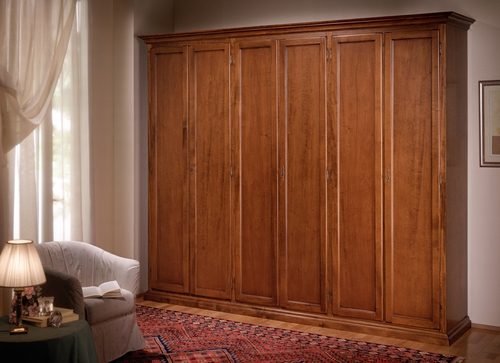
Reclaimed wood, also known as salvaged or recycled wood, refers to timber that has been previously used in structures like old barns, warehouses or factories and is repurposed for new applications such as cupboard construction.
Pros:
- Environmental sustainability: Reclaimed wood reduces the demand for virgin timber, helping to preserve forests and reduce deforestation. It also prevents old wood from ending up in landfills, promoting eco-friendliness and sustainability.
- Unique character: Each piece of reclaimed wood carries its own history, with distinctive marks, knots, and patina that add character and charm to cupboards. This uniqueness adds warmth and authenticity to interior space.
- Strength and durability: Reclaimed wood often comes from old-growth trees, which tend to be denser and more durable than newly harvested timber. As a result, cupboards made from reclaimed wood are sturdy and long-lasting.
- Versatility: Reclaimed wood can be sourced from various sources, offering a wide range of species, colours, and textures to suit different design aesthetics and preferences.
Cons:
- Limited availability: Quality reclaimed wood can be scarce and may require extensive sourcing efforts, leading to higher costs compared to conventional materials.
- Inconsistencies: Due to its varied origins, reclaimed wood may exhibit inconsistencies in colour, texture, and size, which can pose challenges during construction and may affect the overall aesthetic appeal.
- Potential for contaminants: Reclaimed wood sourced from old structures may contain contaminants such as lead paint, pesticides, or chemicals used in treatment processes. Proper testing and preparation are necessary to ensure safety.
- Higher maintenance: Reclaimed wood may require more maintenance than other materials, as it may be more susceptible to warping, splitting, or insect infestation if not properly treated and sealed.
Bedroom cupboard materials #7: Veneer sheets
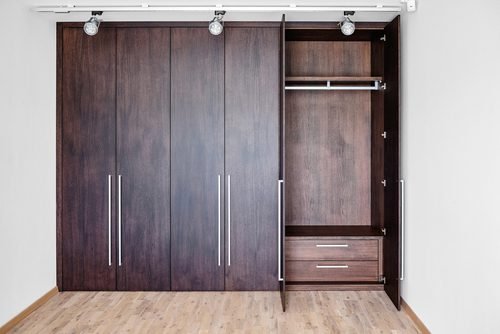
Veneer sheets are thin slices of wood typically ranging from 0.5 to 6 millimetres in thickness, obtained by peeling or slicing logs. These sheets are used to cover the surface of furniture, including cupboards, to achieve the appearance of solid wood at a more affordable cost.
Pros:
- Cost-effective: Veneer sheets provide the aesthetic appeal of solid wood at a fraction of the cost. This makes them an economical choice for homeowners looking to achieve a high-end look.
- Variety: Veneer sheets come in a wide range of wood species, grains, and finishes, allowing for great design flexibility. Whether you prefer the rich tones of oak or the sleek look of walnut, there’s a veneer option to suit every style.
- Environment friendly: Veneer sheets are often made from sustainable sources, with manufacturers using thin slices of wood efficiently to cover larger surface areas. This minimises waste and reduces the demand for solid wood, making veneers an environmentally conscious choice.
- Stability: Unlike solid wood, which can be prone to warping and cracking due to changes in humidity and temperature, veneer sheets are more stable and less susceptible to such issues. This stability ensures that cupboards maintain their appearance and structural integrity over time.
Cons:
- Durability: While veneer sheets offer the look of solid wood, they may not have the same level of durability. Thicker veneers tend to be more resilient, but thinner varieties can be susceptible to scratches, chips, and dents, especially in high-traffic areas.
- Limited repairability: Unlike solid wood, which can be sanded and refinished multiple times, veneer sheets have a thin layer that limits the number of times they can be repaired or refinished. Deep scratches or damage may require the replacement of the sheet.
- Moisture sensitivity: Although veneer sheets are more stable than solid wood, they can still be affected by moisture. Excessive exposure to humidity or water can cause veneers to swell, warp, or delaminate, compromising their appearance and structural integrity.
- Potential for peeling: Poor-quality veneer adhesives or improper application techniques can lead to veneer sheets peeling or lifting over time. Proper installation by experienced professionals is essential to ensure long-lasting performance.
Bedroom cupboard materials #8: PVC boards
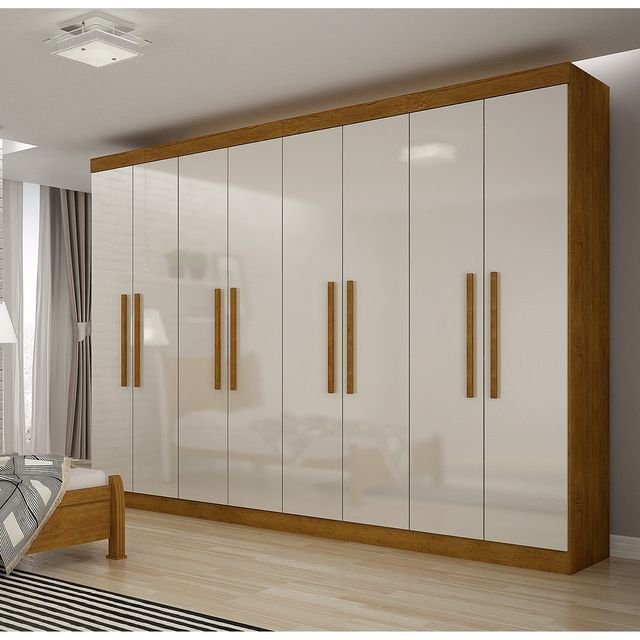
Source: Pinterest (633387440432546)
PVC (Polyvinyl Chloride) boards are a type of synthetic material commonly used in various applications, including cupboard construction. These boards are made from a combination of PVC resin and additives, providing a durable and versatile alternative to traditional wood-based materials.
Pros:
- Waterproof: One of the primary advantages of PVC boards is their waterproof nature. Unlike wood-based materials, PVC boards do not absorb moisture, making them ideal for use in environments prone to humidity, such as kitchens and bathrooms.
- Low maintenance: PVC boards are easy to clean and maintain, requiring only regular wiping with a cloth to remove dust and dirt. They are resistant to stains, scratches, and fading, ensuring long-lasting performance with minimal upkeep.
- Durability: PVC boards are highly durable and resistant to impact, making them suitable for high-traffic areas. They do not warp, rot, or splinter like wood, ensuring that cupboards maintain their appearance and structural integrity over time.
- Versatility: PVC boards come in a wide range of colours, textures, and finishes, allowing for endless design possibilities. Whether you prefer a sleek modern look or a rustic woodgrain finish, there’s a PVC board option to suit every style and aesthetic preference.
- Cost-effective: PVC boards are often more affordable than natural wood or other synthetic materials, making them a budget-friendly option for cupboard construction. Additionally, their low maintenance requirements help save on long-term costs associated with upkeep and repair.
Cons:
- Not environment friendly: PVC boards are made from synthetic materials derived from non-renewable resources, making them less environment friendly than natural wood or sustainable alternatives. Proper disposal and recycling practices are essential to minimise their environmental impact.
- Limited thermal stability: PVC boards may expand or contract in response to changes in temperature, particularly extreme heat, which can affect their dimensional stability. Proper installation and adequate ventilation are necessary to mitigate potential issues related to thermal expansion.
- Vulnerability to UV exposure: Prolonged exposure to sunlight can cause PVC boards to discolour or degrade over time. UV-resistant coatings or protective treatments may be required to preserve their appearance and performance in outdoor or sun-exposed applications.
- Not suitable for structural applications: While PVC boards are strong and durable, they may not be suitable for structural applications requiring load-bearing support. Careful consideration should be given to the intended use and placement of PVC boards to ensure they meet the necessary structural requirements.
Bedroom cupboard materials #9: Metal and wire mesh
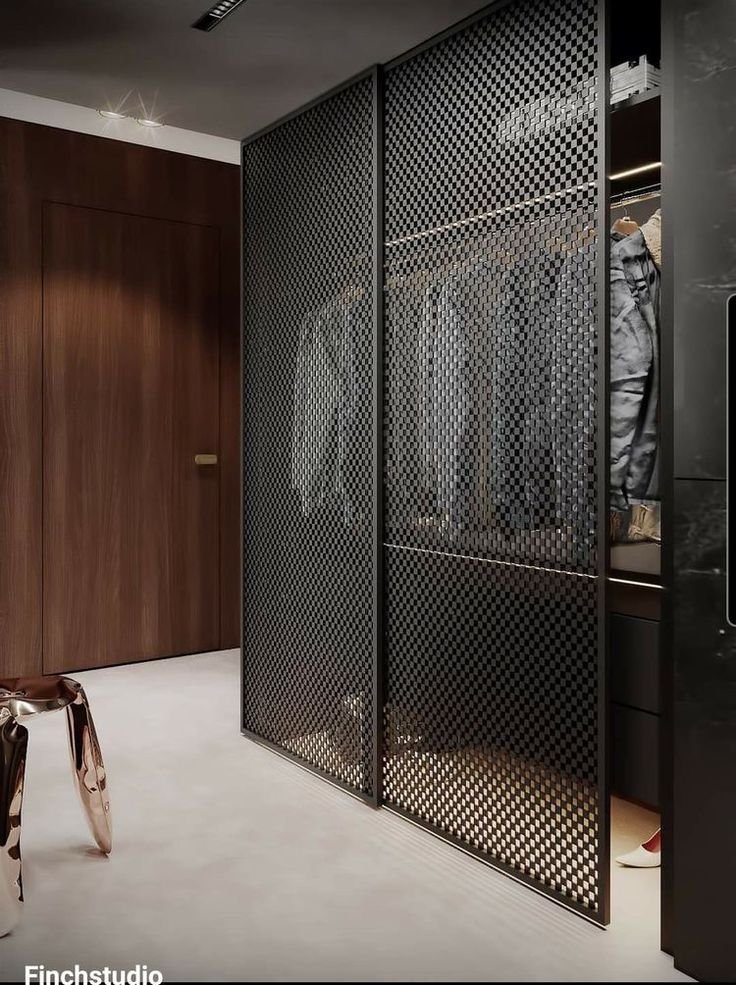
Source: Pinterest/lauragarcia5283
Metal and wire mesh are alternative materials used in cupboard construction, offering unique properties and aesthetic appeal. These materials provide a modern and industrial look, suitable for contemporary and minimalist design schemes.
Pros:
- Durability: Metal and wire mesh cupboards are highly durable and resistant to wear and tear. They can withstand heavy use and are less susceptible to damage from impacts or moisture compared to traditional wood-based materials.
- Ventilation: Wire mesh allows for excellent ventilation, preventing musty odours and mildew growth inside the cupboard. This feature is particularly beneficial for storing items that require airflow, such as linens, shoes, or electronic equipment.
- Visibility: Wire mesh provides visibility into the cupboard’s contents, making it easy to locate and access stored items without the need to open the doors. This can be advantageous for organising and displaying items, enhancing the overall functionality of the cupboard.
- Modern aesthetic: Metal and wire mesh cupboards offer a sleek and contemporary aesthetic that complements modern interior design styles. The clean lines and open framework of wire mesh add visual interest and texture to the space, creating a focal point in the room.
- Customisation: Metal and wire mesh cupboards are highly customisable, allowing for various design options and configurations. Different metal finishes, colours, and mesh patterns can be chosen to suit individual preferences and match existing decor elements.
Cons:
- Limited privacy: While wire mesh provides visibility, it also lacks privacy compared to solid cupboard doors. Items stored inside the cupboard are partially exposed, which may not be ideal for concealing clutter or personal belongings.
- Susceptibility to rust: Depending on the type of metal used, wire mesh cupboards may be prone to rust or corrosion, especially in humid environments or areas with high moisture levels. Proper maintenance and periodic treatment with rust-resistant coatings are necessary to prolong their lifespan.
- Scratch susceptibility: Metal surfaces can be susceptible to scratches and dents, detracting from their appearance over time. Care should be taken when handling objects to avoid causing damage to the metal finish.
- Noise: Metal and wire mesh cupboards may produce more noise when opening and closing compared to their wood counterparts. The metal-on-metal contact can create clanking or rattling sounds, which may be disruptive in quiet environment.
- Cost: Metal and wire mesh cupboards may be more expensive than traditional wood-based options, depending on the quality of materials and construction methods used. Higher-end finishes or custom designs can further increase the cost of installation.
Bedroom cupboard materials #10: Unfinished pine
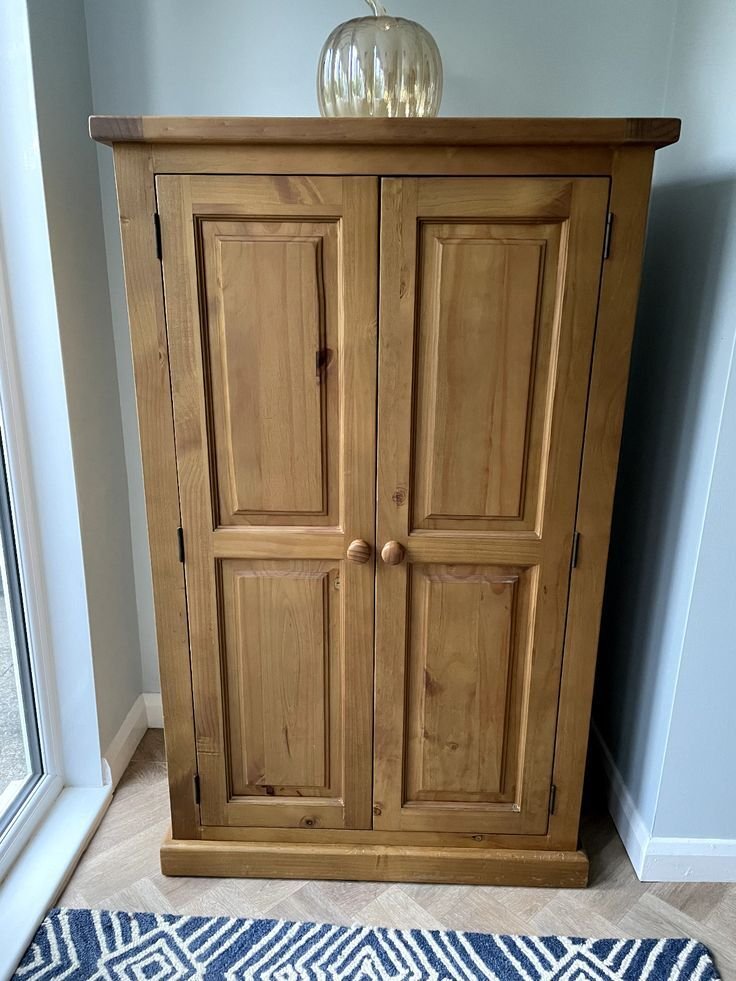
Source: Pinterest/antiqueauctionsnow
Unfinished pine is a popular choice for cupboard construction, valued for its natural beauty, affordability, and versatility. This material offers a rustic charm and warmth to any space, making it a favoured option for both traditional and contemporary interior designs.
Pros:
- Affordability: Unfinished pine is generally more budget-friendly compared to other wooden materials, making it an attractive option for those seeking cost-effective cupboard solutions without compromising on quality.
- Natural aesthetic: The natural grain and knots of unfinished pine wood lend a rustic and authentic character to cupboards, adding warmth and charm to the room. Its light colouration also creates a bright and airy feel, ideal for smaller space or rooms with limited natural light.
- Ease of maintenance: Despite being unfinished, pine wood is relatively easy to maintain and can withstand daily wear and tear. Minor scratches or imperfections can be sanded out and refinished as needed, prolonging the life of the cupboard.
- Environment friendly: Pine is a sustainable and renewable resource, with many suppliers sourcing wood from responsibly managed forests. Choosing unfinished pine for cupboards promotes eco-friendly practices and reduces environmental impact.
Cons:
Susceptibility to damage: Unfinished pine is softer and more susceptible to dents, scratches, and water damage compared to hardwoods. Care must be taken to avoid excessive moisture exposure or impact to maintain the integrity of wood.
Prone to discolouration: Pine wood may develop a yellowish or amber hue over time, especially when exposed to sunlight or certain finishes. This natural ageing process can alter the appearance of cupboard, requiring periodic maintenance to preserve its original colour.
- Limited durability: While pine is durable for everyday use, it may not be as resilient as hardwoods, such as oak or maple. Heavy items or rough handling may cause dents or indentations in wood, detracting from its appearance over time.
- Vulnerability to pests: Pine wood is susceptible to infestation by wood-boring insects, such as termites or beetles if not properly treated or sealed. Regular inspection and preventive measures are necessary to protect unfinished pine cupboards from pest damage.
Prices of budget-friendly cupboard materials for bedroom
Below are the price range for bedroom cupboards crafted from various budget-friendly materials.
- Plywood cupboards: Prices typically start from Rs 15,000 for a small, basic cupboard and can exceed Rs 1 Lakh depending on size and design.
- Unfinished pine and MDF cupboards: Both usually start at Rs 10,000 and can go beyond Rs 50,000, varying based on factors like finish, size, and design.
- Laminate cupboards: Prices can start at Rs 12,000 and go beyond Rs 50,000.
- Veneer sheet cupboards: Typically range between Rs 20,000 and Rs 1 Lakh.
- Reclaimed wood and PVC board cupboards: Available at a relatively lower price, starting around Rs 8,000. Large-sized PVC board cupboards can be obtained for around Rs 25,000, making them one of the most budget-friendly options for cupboards.
Budget bedroom cupboard: Top brands
Several reputable brands in India provide bedroom cupboards crafted from a variety of affordable materials. Here are some of the brands.
- Pepperfry
- Durian
- Urban Ladder
- Nilkamal
- Godrej Interio
- Evok
- HomeTown
- Flipkart Furniture
Housing.com POV
Selecting the right material for your bedroom cupboard is crucial for achieving both functionality and aesthetics, especially when operating within a budget. Each material comes with its own set of advantages and drawbacks, catering to different preferences and requirements. Whether you opt for the affordability and versatility of particleboard, the balance of cost and quality with MDF, the strength and durability of plywood, or the affordability and variety of laminate, there’s a budget-friendly option to suit your needs. Additionally, materials like melamine, reclaimed wood, veneer sheets, PVC boards, metal, wire mesh, and unfinished pine offer unique characteristics and design possibilities.
Considering factors, such as durability, moisture resistance, maintenance requirements, environmental impact, and cost can help you take an informed decision. Further, reputable brands like Pepperfry, Durian, Urban Ladder, Nilkamal, Godrej Interio, Evok, HomeTown, and Flipkart Furniture offer quality bedroom cupboards crafted from various affordable materials, providing assurance of both reliability and affordability in your choice.
FAQs
What is the most budget-friendly material for bedroom cupboards?
Particleboard is often considered the most budget-friendly material for bedroom cupboards. It is cost-effective and versatile, making it an ideal choice for those looking to save money without compromising on quality.
Are MDF cupboards durable enough for everyday use?
Yes, Medium Density Fiberboard (MDF) cupboards are durable enough for everyday use. While they may not be as strong as solid wood or plywood, MDF cupboards offer sufficient durability and stability for most household storage needs.
Can plywood cupboards withstand moisture and humidity?
Plywood cupboards are known for their resistance to moisture and humidity, especially when compared to materials like particleboard or MDF. However, it's essential to choose the right grade of plywood and apply appropriate finishes to enhance its moisture resistance.
Is laminate easy to maintain and clean?
Yes, laminate surfaces are easy to maintain and clean. Regular wiping with a damp cloth is usually sufficient to remove dust and dirt. Additionally, laminate is highly resistant to stains and moisture, making it an excellent choice for bedroom cupboards.
Are PVC board cupboards environment friendly?
PVC boards are not considered environment friendly due to their synthetic nature and reliance on non-renewable resources. However, some manufacturers offer eco-friendly PVC options with reduced environmental impact, making them a more sustainable choice for those concerned about environment.
| Got any questions or point of view on our article? We would love to hear from you. Write to our Editor-in-Chief Jhumur Ghosh at [email protected] |

Dhwani is a content management expert with over five years of professional experience. She has authored articles spanning diverse domains, including real estate, finance, business, health, taxation, education and more. Holding a Bachelor’s degree in Journalism and Mass Communication, Dhwani’s interests encompass reading and travelling. She is dedicated to staying updated on the latest real estate advancements in India.
Email: [email protected]
